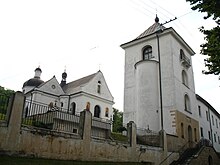Onuphrios Monastery (Lviv)
The Onuphrios Monastery is a monastery in the old town of Lviv in Ukraine . It belongs to the Ukrainian Greek Catholic Church .
history
The beginnings of the Onuphrios Church are unclear. The monastery was first mentioned in 1453 on the occasion of expansion buildings. Around 1550 a stone church and a bell tower were built. Since then, the monastery has been under the city's Orthodox brotherhood .
In 1573 the well-known printer Ivan Fyodorov came to the monastery with his printing works. He died in 1583 and was buried there. In 1585 the monastery was given a stone wall. In 1591 a hospital was established. The printing works closed in 1615. In 1623 the monastery was damaged by fire.
In 1633 a brotherhood of citizens and clergy was established to support the work of the hospital and run a school for poor boys. In 1655 the monastery was damaged again and in 1676 it was badly destroyed by a Tatar attack. In 1680 extensive renovations took place.
In 1709 the Onuphrios Monastery joined the United Greek Catholic Church . In 1767 it was given to the Order of the Basilians . From 1815 to 1820 extensions took place. A new bell tower, a printing shop and a large library were built. The monastery became the center of the Basilians in Galicia. From 1821 to 1824 a sacristy and a presbytery were added to the church. The last structural changes took place in 1902. In 1908 a new iconostasis was built.
In 1939 the library owned over 40,000 books, the monastery archive, and numerous icons and paintings. In 1946 the monastery was closed. An ethnographic museum was established and in 1977 a museum on the history of printing.
In 1990 the monastery was returned to the Order of the Basilians and the Ukrainian Greek Catholic Church. In 2011 there were 14 monks and 8 novices living in the monastery.
architecture
The Onuphrios Church is preserved in the Renaissance style of the 1680 reconstruction. The bell tower was rebuilt in 1820.
Web links
- Drone movie
- Saint Onuphrios's Church and Monastery Encyclopedia of Ukraine
Remarks
- ^ Catalogus Ordinis Basiliani Sancti Iosaphat . Romae, Apud Curiam Generalem Ordinis 2011, pp. 134-138.
Coordinates: 49 ° 50 ′ 58 ″ N , 24 ° 1 ′ 44 ″ E
